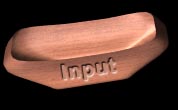 |
The Input and Output Trays
These are what we use to communicate with the little man. We provide
him with data via the input tray, and when he's ready, he provides us
with data via the output tray.
|
The Execute Process
Once the little man knows which instruction he
is going to perform, he has to set about actually doing it. This is the
'Execute' phase of the fetch execute cycle.
For each instruction the little man will perform
a series of tasks. For instance, for an input instruction, the little
man will go to the input tray, take the value he finds there, and go and
put it into the calculator. For an add instruction, he will take a value
from memory, and add it to the value presently in the calculator.
Once the execute phase is complete, the little
man will start the cycle again , and head to the program counter to get
the value of the next instruction he has to fetch.
|









